Celebrating New Year’s Day (Ganjitsu) in Japan
1st January, New Year’s Day also known as Ganjitsu is the most important holiday in Japan. For your information, Gan means “beginning” and Jitsu means “Day”. Ganjitsu is a joyous holiday that marks a new and fresh beginning into the year. After your New Year’s Eve countdown (you may refer to another entry here: New Year’s Eve Countdown Options in Japan), you may want to learn to celebrate New Year’s Day like the Japanese as follows:
http://jrvacation.com/celebrating-new-years-day-in-japan/
(1) Exchange Hearty Greetings

Akemashite omedetou gozaimasu! Fyi, the pine and bamboo arrangement (left and right) is known as Kadomatsu. You will see them on both sides of the main door at residential or hotels to welcome god of the new year to the house/building. The Kagami-mochi (center) is the new year’s cake and it is another decoration to welcome the god. Image source: 
Start your New Year’s Day by extending customary hearty greetings when you meet others, for example to the waiter/waitress at restaurant/cafe or the service staff at convenience stores. I’m sure they will be surprised and delighted to hear that from a tourist! Let’s learn the most common greetings:
Akemashite omedetou gozaimasu (“Happy New Year” – formal style).
Akemashite omedetou (“Happy New Year” – casual style).
(2) View the First Sunrise (Hatsuhinode)
Crowd at Tokyo Tower for Hatsuhinode. Image source: 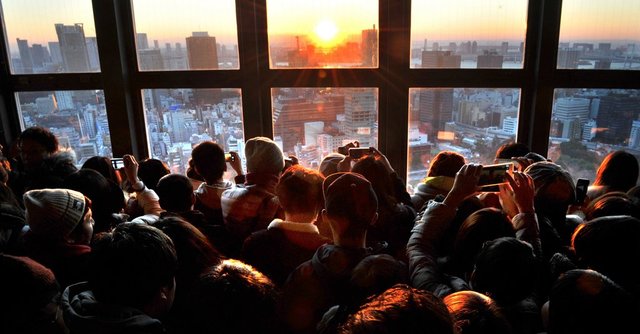
Japanese believes that watching the first sunrise on New Year’s Day, also known as Hatsuhinode will bring luck for the whole year. As such, if you are an early riser, why not consider joining lots of locals to view sunrise on New Year’s Day? Popular locations for hatsuhinode in Tokyo include:
(a) Tokyo Tower
– Opens at 6am on 1st of January. In 2017, the admission fee for hatsuhinode was 900 yen and special “2017.1.1” medals were distributed to visitors on first-come-first-serve.
– You may like to monitor their website for information on 2018 hatsuhinode viewing.
Address: 4 Chome-2-8 Shibakoen, Minato, Tokyo 105-0011, Japan
Website: https://www.tokyotower.co.jp/event/en.html
(b) Tokyo Sky Tree
– Entry time at 5.30am. Tokyo Sky Tree sells their 892 tickets through the following channels:
– Website lottery for 570 tickets. Application period: 01 November to 26 November 2017. Lottery results announcement: 28 November 2017. Website: http://w.pia.jp/a/skytree20180101/
– Tobu Top Tours Day-Package limited to 110 persons from 5am to 9am, inclusive of New Year’s breakfast at 13,900 yen per person. For more details, please refer to official website (Japanese): https://tobutoptours.jp/tabiclub/skytree_hatsuhinode/
– Special packages with Tobu Hotel Levant Tokyo, Daiichi Hotel and Asakusa View Hotel. Do contact the hotels directly for more information.
Address: 1 Chome-1-2 Oshiage, Sumida, Tokyo 131-0045, Japan
Website: http://www.tokyo-skytree.jp/news/info/48
(3) Eating Osechi Ryori with Iwai-bashi
Plastic samples of Osechi ryori on display at Shinjuku Takashimaya food market level for order-taking from as early as October onwards.
It is a tradition for Japanese to share Osechi Ryori among family and friends on New Year’s Day. Osechi Ryori is a cuisine that presents significant traditional Japanese food attractively in a 3 or 4 tier bento box, known as jubako. Each item in the jubako has a significant meaning and some common food items include:
Daidai (Japanese bitter orange): wish for children / continuing generations in the household.
Datemaki (Sweet rolled omelette with fish paste): wish for auspicious days in the year.
Konbi (a type of seaweed): symbolizes joy and happiness.
Kuro-mame (black soybeans): wish for good health.
Kazu no ko (Herring roe): wish for good fortune to descendants.
Tazukuri (fried sardines in soy sauce): symbolizes abundant harvest.
Ebi (prawns): wish for long life.
Nishiki tamago (Silk brocade egg): symbolizes good fortune / wealth.
Renkon (lotus roots): wish for a smooth year without obstacles.
An interesting fact: Osechi ryori is eaten using a special type of chopsticks known as Iwai bashi. Both ends of iwai bashi are pointed; 1 pointed side is used by the holder and the other side is used by deity. It is believed that sharing the osechi ryori with the deity using iwai bashi will blessed you with a fruitful year.
Comparison of a pair of Iwai Bashi (bottom) vs a pair of normal chopsticks (top). Image source:
Traditionally, the osechi ryori is typically prepared in advanced and preserved so that the woman in the household could rest during the New Year holiday. However, it is now more common for Japanese families to order in advance from as early as autumn from departmental stores, supermarkets, restaurants or even convenient stores, depending on their budget. A set of osechi ryori could range from 10,000 yen in a convenient store to 32,000 yen in a departmental store. You may like to keep a lookout and try the osechi ryori served in your hotel restaurants or ryokans for a successful and auspicious year ahead!
(4) Visit a Shrine or Temple (Hatsumode)
Image source: 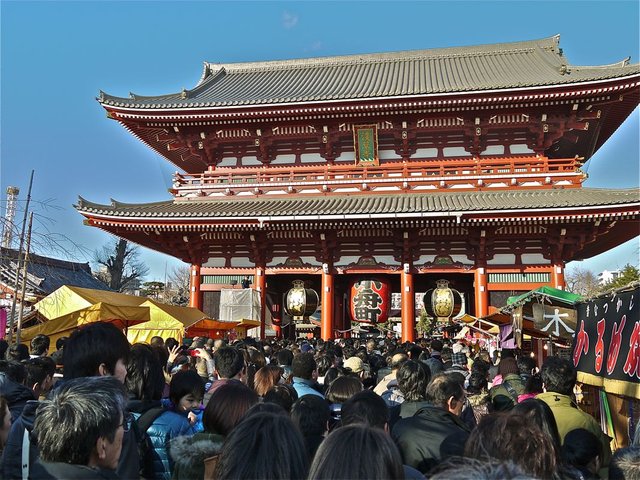
Visiting a shrine or temple, dressed in kimono to obtain blessings and good fortune during the New Year period is another custom followed by the Japanese. The first visit to a shrine or temple during New Year is known as hatsumode and this activity is usually accompanied by family and friends after consuming the osechi ryori at home. As such, be prepared for the bustling and massive crowd if you intend to visit famous temples and shrines on New Year’s Day! Meiji Shrine and Senso-ji at Asakusa in Tokyo receive a few millions of visitors during the full New Year holiday each year! You may also like to follow the New Year’s custom and draw fortune lots known as omikuji or purchase amulets known as omamori. Note: if you receive a unlucky omikuji, do tie it at the designated spot on the temple or shrine to avoid the predicted misfortune.
These are the unlucky omikuji. 🙁 Image source: 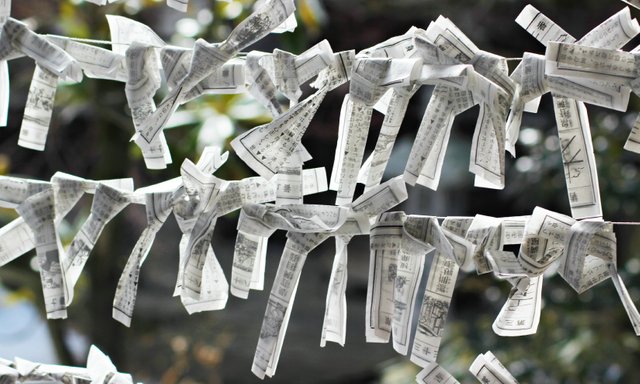
Omamori makes great souvenirs too! Image source: 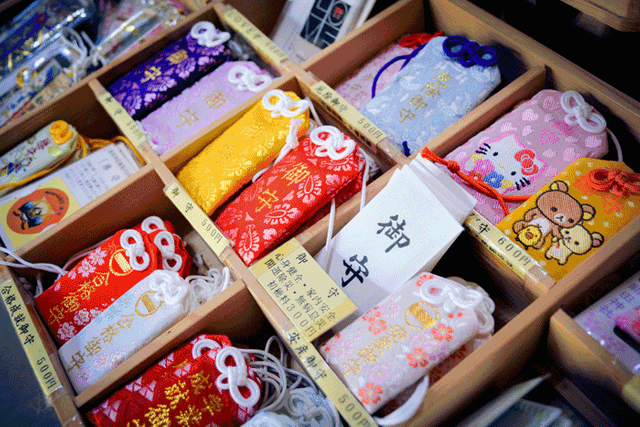
If you are visiting a shrine, follow the following manners for worship:
Give a little bow in front of the Torii (the gate)
Walk on the side pedestrian paths of the Sando (path leading to the shrine). Do not walk in the central path as that is meant for the god.
Wash your hands before worship at Chozuya (the purification water fountain/pavilion).
Give a little bow and ring the Suzu (bell).
Throw money into the Osaisen (Offering box). People usually offer five-yen coin, translated as “go-en” in Japanese, which symbolises goodluck.
The “Nirei-nihakushu-ichirei”: bow low twice – put your palms together and clap twice – bow low once at the end.
If you are visiting a temple, follow the following manners for worship:
Bow in front of the Sanmon (the main entrance of the temple).
Walk along the roadside and wash your hands at the Chozuya (the purification water fountain/pavilion).
Lights incense sticks and offers it at the Osenko (incense burner).
Throw money into the Osaisen (Offering box). People usually offer five-yen coin, translated as “go-en” in Japanese, which symbolises goodluck.
The Hondo: Put your palms together and pray – bow at the end. Note: Do not clap your hands.
Simple illustration on the differences between a temple and a shrine. Image source: https://japan.aminoapps.com/page/item/shrine-or-temple/rdsq_IxLGovWB5Gm7DoxNwMzqVBNgZ
(5) Queue for a Happy Bag (Fukubukuro) at the First Sale of the New Year (Hatsu-uri)
Hatsu-uri at a departmental store with numerous fukubukuro up for grabs! Image source: 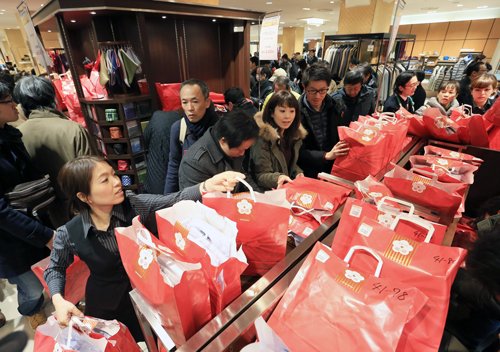
Most companies in Japan close for around a week from end December to first week of January for their employees to rest and enjoy the New Year holidays. However, tourists can rest assured that departmental stores, shopping malls, convenience stores and restaurants remain open. In fact, this is the best shopping period to be in Japan as all departmental stores, shopping malls and literally every shopping streets begin their mega nation-wide first sale of the year, known as Hatsu-uri on New Year’s Day. The sale discount during this period usually vary from 30 – 70%. A distinctive feature of the Hatsu-uri is the sale of “Happy Bags”, known as Fukubukuro. Fukubukuro are sealed bags filled with items from the same shop or brand, and the general rule is that each fukubukuro must be priced much lower than the actual total value of these items, making it a real great bargain. Some shops may disclose the category of items they are placing in the Fukubukuro but the price saving strategy remains. Popular brands of fukubukuro sought after in Japan include those from Apple Store, Muji, Starbucks, Cecil McBee and various shopping malls, with queues forming from 31 December onwards! Highly recommended to bring more cash and be prepared to shop till you drop during Hatsu-uri!
Fukubukuro from Adidas
Fukubukuro from PARIS KID’S at Takeshita Dori (Harajuku).
Hatsu-uri everywhere at Takeshita Dori, Harajuku.
Hatsu-uri at tutu-anna at Takeshita Dori, Harajuku.
If you are visiting friends or relatives in Japan and they have children….
(6) Giving Ang Bao Money to Children (Otoshidama)
Similarly to our Asian’s Chinese tradition, it is a custom for adults to give “ang bao money”, known as Otoshidama to children during New Year holidays. The otoshidama are placed in small envelope packets (ang bao packets) known as pochibukuro, which are often decorated with auspicious images. The amount of otoshidama is typically based on the age and relationship to the child. The average amount of otoshidama for a child in elementary is 1,000 to 3,000 yen, junior high student is 3, 000 to 5,000 yen and senior high student is 5,000 to 10,000 yen. As such, do prepare otoshidama for the children of your friends and relatives whom you are visiting in Japan!
I hope these useful tips will help you to understand the Japanese culture of Ganjitsu celebration and plan for a fulfilling New Year’s Day.
Stay warm, enjoy the crowd and shopping!
Love, Miwa